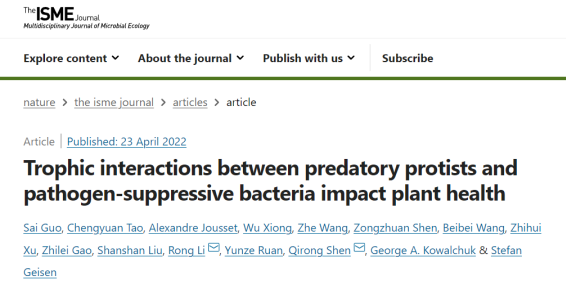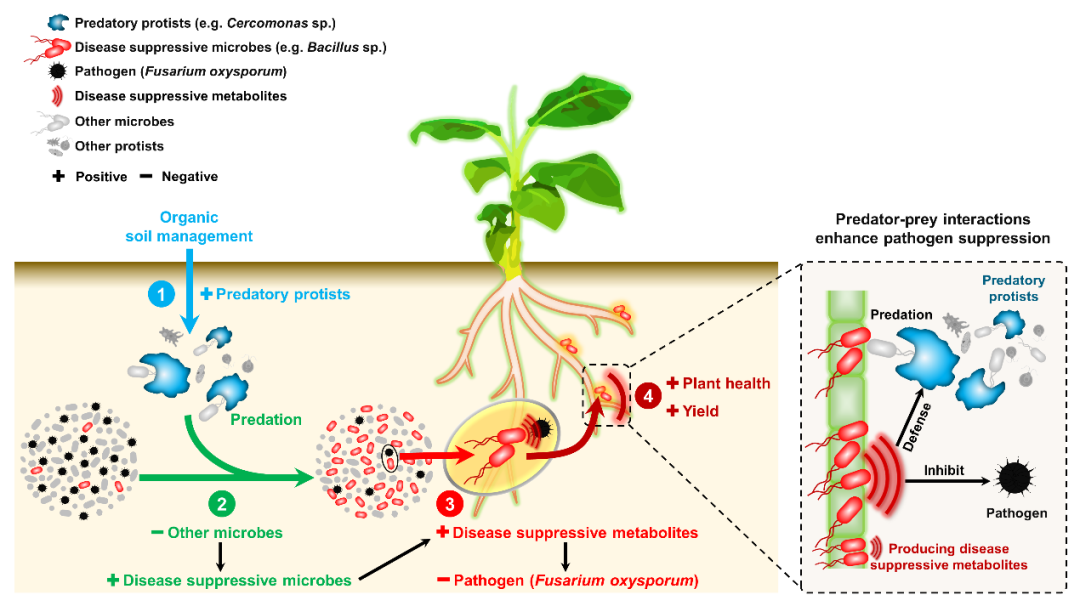On April 23, local time, The ISME Journal, a well-known journal in the field of microbiology, published online the latest research results of the Soil Microbiology and Organic Fertilizer Team of the School of Resources and Environmental Sciences of Nanjing Agricultural University on the interaction of protists and bacteria on crop health ( Trophic interactions between predatory protists and pathogen-suppressive bacteria impact plant health). The results reveal the interaction mechanism between predatory protists and disease-suppressing Bacillus bacteria driven by long-term organic fertilizer application and their important role in promoting crop health.

Plant health is strongly influenced by beneficial and pathogenic microorganisms that are modulated by resource inputs. In addition, soil microbes are regulated from the top down by predators such as predatory protists. However, little research has been done on the mechanism of interaction between soil predatory protists and other microorganisms. This paper investigated the effects of long-term organic fertilizer application on the composition and function of soil and crop root-associated microbial communities (bacteria, fungi, and protists), aiming to decipher the role of predator-prey interactions in regulating crop health. The study found that the interaction of predatory protists and bacteria is an important driving factor for organic fertilization mode to reduce the occurrence of fusarium wilt and improve banana yield. Among them, the predation behavior of predatory protists promotes the expression of disease-suppression-related secondary metabolite synthesis genes (such as non-ribosomal peptide synthase genes) in the microbiome, which is the interaction between predatory protists and functional bacteria (Bacillus). as a potential mechanism of disease suppression. This finding revealed that the interaction of predatory protists and bacteria under organic fertilization mode can protect crop health by stimulating the abundance of beneficial bacteria and the expression of disease-suppressing functions in the microbial community of crop roots.

Our doctoral student Guo Sai and Zhongshan Young Researcher Dr. Tao Chengyuan are the co-first authors of the paper, and Professor Li Rong and Academician Shen Qirong are the corresponding authors. Team Professor Xiong Wu, Associate Professor Shen Zongzhuan, Associate Professor Xu Zhihui, Master Wang Zhe, PhD student Liu Shanshan, Professor Ruan Yunze and Associate Professor Wang Beibei of Hainan University, Professor George Kowalchuk of Utrecht University, Netherlands, Assistant Professor Alexandre Jousset, Dr. Gao Zhilei, Wach Assistant Professor Stefan Geisen of the University of Ningen and others participated in the research. The research was funded by the National Natural Science Foundation of China and other projects.
Full text link:
https://www.nature.com/articles/s41396-022-01244-5
Citation:
Sai Guo, Chengyuan Tao, Alexandre Jousset, Wu Xiong, Zhe Wang, Zongzhuan Shen, Beibei Wang, et al. 2022. Trophic interactions between predatory protists and pathogen-suppressive bacteria impact plant health. The ISME Journal https://doi.org /10.1038/s41396-022-01244-5
Editor: Velina
Proofreading: Li Rong
Edited by: Quan Simao
Source: School of Economics and Environment, Nannong University, original link: https://mp.weixin.qq.com/s/gNGUtme8E2yYi6PaIY5Wfg
you may also like
10000+: Microflora Analysis Baby and Cats and Dogs Syphilis Rhapsody Extracts DNA Issues Nature Cell Special Issue Gut Commands Brain
Tutorial Series: Introduction to the Microbiome Biostar Microbiome Metagenomics
Professional skills: Indispensable people for academic charts , high- scoring articles , and students' letter collections
Read the article: The evolutionary tree of metagenomic parasite benefits
Required Skill: Ask Question Search Endnote
Literature Reading Enthusiastic SemanticScholar Geenmedical
Amplicon Analysis: Graph Interpretation Analysis Process Statistical Plotting
16S function prediction PICRUSt FAPROTAX Bugbase Tax4Fun
Online Tool: 16S Predictive Media Bio-Information Mapping
Scientific research experience: cloud note cloud collaboration public account
Programming Template: Shell R Perl
Biological science: Gut bacteria , life on the human body, the great leap of life
write on the back
In order to encourage readers to communicate and quickly solve scientific research difficulties, we have established a "metagenomics" professional discussion group, and currently there are more than 5000 front-line researchers at home and abroad to join. Participate in the discussion and get professional answers. Welcome to share this article to the circle of friends, and scan the code to add the editor-in-chief friend to bring you into the group. Be sure to note "name-unit-research direction-title/grade". PI, please indicate your identity, and there are also PI groups related to microorganisms at home and abroad for cooperation and exchanges. For help with technical problems, first read "How to Ask Questions Elegantly" to learn how to solve the problem.

Learn 16S amplicons, metagenomics scientific research ideas and analysis practice, and pay attention to "metagenomics"
Click to read the original text, jump to the latest article directory to read